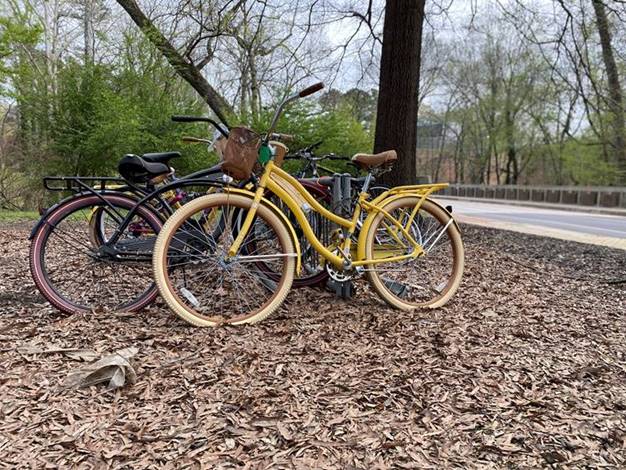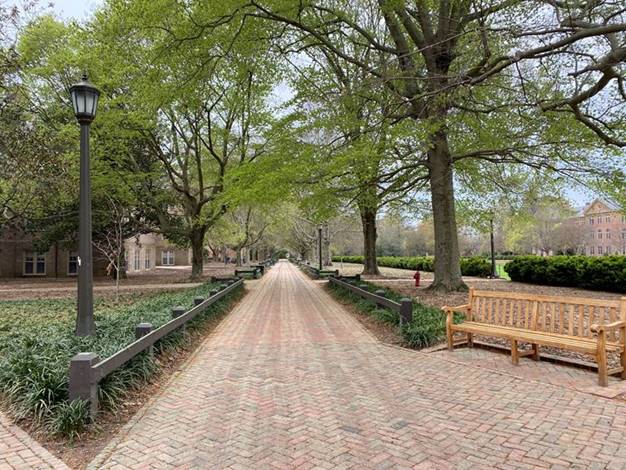The Yellow Bicycle

Williamsburg, March 30, 2020: These are trying days, with massive disruptions and deep concern for loved ones and friends. This concern, in my mind anyway, churns together with an unbounded awe and appreciation for the frontline workers, which in this COVID-19 pandemic, include not only healthcare workers, who are this moment working in horrific battlefield conditions, without sufficient equipment and support, but also warehouse and delivery workers, and restaurant, supermarket, and pharmacy employees, who are also risking their lives getting food and medicine to all of us. And many others as well.
As I live and work here in Williamsburg, I thought I’d share a story about the pandemic that might capture the overturning of our worlds from a W&M perspective. One day, which feels far away, we will be past this topsy-turvy time and the rawness will be behind us. I want, though, to record right now how fast things changed on campus. The story is told with a humble gratefulness for my family’s current good health, and an understanding that many today are not so fortunate, and that my family may very soon count among those who are tragically affected. I am not immune.
On Friday, March 6, I attended the W&M Libraries Board of Directors meeting on campus. The board meets twice a year. Current students and library fellows treated us with some incredible presentations. Really, we were blown away by every single student and fellow. We visited the Studio For Teaching & Learning Innovation, which is now playing a pivotal role in supporting online and distance learning, and the Entrepreneurship Hub. We had an enjoyable dinner. No one was worried about “social distance.”
Board member David Culver ‘09 is working in China as a reporter for CNN and attended the morning meeting via videoconferencing. He was in Wuhan early in the pandemic and had done some landmark reporting, graphically bringing a faraway story into our consciousness. He told us what felt like wartime stories from the field. We all felt concern for his safety, not ours.
Not that we did not know COVID-19 was coming to us. I follow the news and could see it expanding beyond the Seattle area, where it was already a public health crisis. Confirmed cases were appearing in other states, most notably New York, but not yet in Virginia. Dr. Rowan Lockwood, geology department chair, was at the meeting and expressed informed concern about W&M students heading off that very day for spring break. They would be in large crowds, accelerating the number of infections. That had personal relevance. Our daughter Abigail is a senior and was leaving with eight friends, mostly W&M folks, for New Orleans. Dr. Lockwood also cited modeling that predicted that the virus would be well established in Williamsburg by mid-April.
By that point, I expected the semester to be interrupted, but was still thinking the students would be able to complete a week or two of classes after spring break. Discussions that day did prompt me to get prepared right away. By the following Tuesday, March 10, we had purchased supplies for at least six weeks and completed other necessary tasks.
In the days immediately following, professional sports leagues began to suspend operations, and then no March Madness. The US president addressed the nation. Tom Hanks and Rita Wilson announced positive tests. We were stunned.
On March 11, W&M President Katherine A. Rowe announced the school would be suspending all in-person classes and moving “to online and remote modes of instruction.” Students and other community members who had left for spring break expecting to return to classes in a week or so were soon effectively barred from campus. Some students were able to remove belongings from their dorm rooms, but much remained behind. Events moved quickly, and the crisis made any safe dorm access impossible. Student residences would remain full of clothing, books, small refrigerators, and other college gear.
 Americans hunkered down as the virus gained momentum.
Americans hunkered down as the virus gained momentum.
We live in Williamsburg. With students gone, I started to walk the W&M campus for exercise. It is beautiful and desolate. Flowers are blooming and green is erupting. A scattered few walk around, bending their course to maintain “social distance.” I felt blessed to have access to my alma mater, and sad too, but in a vague way. Besides COVID-19, something about the campus itself was making me sad.
Today, a Monday, I decided to get to campus by 10:30 a.m. I wanted to take one hour, which would normally be very alive with students and others, to photograph the desolation of pandemic. As I walked through campus, almost alone, thinking about what to photograph, and how, I discovered what was, for me, most sad about the campus, a place that feels more like home than anywhere else. It was the bicycles.
 The racks are full of bicycles. We can’t see the college gear locked away in the dorms. But there are the bicycles, everywhere, sitting abandoned, left when students departed for a short break, but now long to return. That’s the sadness, they are all the young lives disrupted and challenged.
The racks are full of bicycles. We can’t see the college gear locked away in the dorms. But there are the bicycles, everywhere, sitting abandoned, left when students departed for a short break, but now long to return. That’s the sadness, they are all the young lives disrupted and challenged.
And then I realized why every day, on my walks, one particular bicycle always snapped me from my thoughts. It’s a yellow bicycle—bright and sunny and stylish—resting at the end of a rack at Randolph Complex, across from DuPont Hall, near the bridge on Ukrop Way.
I had arrived at DuPont on my eighteenth birthday. Now, today, directly across the street, is this yellow bicycle, left behind as we all prepare for a very hard time. It’s distinctive, and would naturally attract a little attention. But I think it’s the bicycle’s forlorn sunniness that strikes me just a little more than all those other bicycles. At a place of easier days, for me, it leans, bright and dark, left behind, one life not in motion, or less so, or differently so, among many. On that rack, my own mortality leans, as do our aspirations for those students and fellows to move forward in a safe and secure environment.
Students will return, things will be better, here at W&M, and everywhere. For today, be safe and help those who need help.

